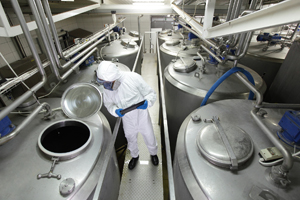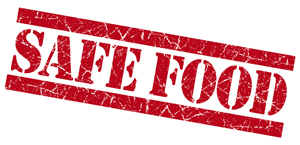
FSSC 22000 Food Certification
FSSC 22000
FSSC 22000 is a GFSI recognised food safety certification scheme that is growing in popularity throughout the world. The FSSC 22000 scheme sets out the requirements for certification bodies to develop, implement and operate a certification scheme to assess the food safety systems of food organisations and to issue a certificate. Initially approved in 2010, the FSSC 22000 certification scheme was successfully re-benchmarked and recognized by GFSI against GFSI Guidance Document Version 6 in February 2013.
The FSSC 22000 scheme based on the food safety management standard ISO 22000, relevant food sector publicly available specifications or ISO technical specifications for food safety prerequisite programs and ISO/TS 22003 Food safety management systems – Requirements for bodies providing audit and certification of food safety management systems. This allows the scheme to cover a broad range of food sector categories as ISO 22000 covers fundamental food safety management requirements whilst relevant food sector category prerequisite programmes are prescribed in separate specifications that are specific to the food sector. In the case of food manufacturers that process or manufacture animal products perishable vegetal products, products with a long shelf life and (other) food ingredients like additives, vitamins and bio-cultures the FSSC 22000 scheme is based on ISO 22000: 2005 ‘Food safety management systems – Requirements for any organization in the food chain’ and ISO/TS 22002-1:2009 ‘Prerequisite programmes on food safety – Part 1: Food manufacturing’.
So there are 3 elements to meeting the requirements of FSSC 22000 and achieving certification:
- A. Compliance with ISO 22000
- B. Compliance with Food Sector Category Prerequisite Programmes
- C. Compliance with FSSC 22000 additional requirements
A. Compliance with ISO 22000 ISO 22000 requirements
Requirements are described in the clauses of ISO 22000:2005 Food safety management systems – Requirements for any organization in the food chain. The clauses are listed below:
- 4. Food Safety Management System
- 4.1 General Requirements
- 4.2 Documentation
- 4.2.2 Document Control
- 4.2.2 Document Control
- 4.2.3 Record Control
- 5. Management Responsibility
- 5.1 Management Commitment
- 5.2 Food Safety Policy
- 5.3 FSQMS Planning
- 5.4 Responsibility & Authority
- 5.5 Food Safety Team Leader
- 5.6 Communication
- 5.6.1 External Communication
- 5.6.2 Internal Communication
- 5.7 Contingency preparedness and response
- 5.8 Management Review
- 6. Resource Management
- 6.1 Provision of Resources
- 6.2 Human Resources
- 6.2.2 Competence, Awareness and Training
- 6.3 Infrastructure
- 6.4 Work Environment
- 7. Planning and Realisation of Safe Products
- 7.1 General Planning and Realisation of Safe Products
- 7.2 Prerequisite Programmes:
- a) construction and lay-out of buildings and associated utilities
- b) lay-out of premises, including workspace and employee facilities
- c) supplies of air, water, energy and other utilities
- d) supporting services, including waste and sewage disposal
- e) the suitability of equipment and its accessibility
- f) management of purchased materials, supplies, disposals and handling of products
- g) measures for the prevention of cross contamination
- h) cleaning and sanitizing
- i) pest control
- j) personnel hygiene
- k) other aspects as appropriate
- 7.3 Preliminary steps to enable Hazard analysis
- 7.4 Hazard Analysis
- 7.5 Operational Control
- 7.5 Establishing the Operational PRPs
- 7.5 Establishing the Operational Pre-requisites
- 7.6 Establishing the HACCP plan
- 7.7 Updating of preliminary information and documents specifying the PRP(s) and HACCP plan
- 7.8 Verification Planning
- 7.9 Traceability System
- 7.10.1 Corrections
- 7.10.2 Corrective Actions
- 7.10.3 Handling of Potentially unsafe products
- 7.10.4 Withdrawals
- 8. Validation, Verification and Improvement of the FSMS
- 8.1 General
- 8.2 Validation of Control Measure Combinations
- 8.3 Control of Monitoring and Measuring
- 8.4 FSQMS Verification
- 8.4.1 Internal audits
- 8.4.2 Evaluation of Individual Verification results
- 8.4.3 Analysis of results of Verification activities
- 8.5 Improvement
- 8.5.1 Continual Improvement
- 8.5.2 FSQMS updating
B. Compliance with Food Sector Category Prerequisite Programmes
Food Sector Category Prerequisite Programmes are prescribed and referenced in a number of ways, ISO 22000 requires in clause 7.2 that organisations shall select and implement specific “Prerequisite programmes” (PRP’s) for these basic hygiene conditions and shall consider and utilize appropriate information when selecting the programme (e.g. the requirements as prescribed in the codex general principles of food hygiene, codex codes of practices, food safety legislation and possible customer requirements). In addition the FSSC 22000 scheme includes prerequisite programme specifications: ISO/TS 22002-1:2009 ‘Prerequisite programmes on food safety – Part 1: Food manufacturing’ for food manufacturers and PAS 223:2011 ‘Prerequisite programmes and design requirements for food safety in the manufacture and provision of food packaging for food packaging manufacturers’.
Specific food manufacturing prerequisite requirements are prescribed in the sections of ISO/TS 22002-1:2009 ‘Prerequisite programmes on food safety – Part 1: Food manufacturing’:
- 4. Construction and Layout of Buildings
- 4.1 General requirements
- 4.2 Environment
- 4.3 Locations of establishments
- 5. Layout of Premises Workspace
- 5.1 General requirements
- 5.2 Internal design, layout and traffic patterns
- 5.3 Internal structures
- 5.4 Location of equipment
- 5.5 Laboratory facilities
- 5.6 Temporary/mobile premises and vending machines
- 5.7 Storage of food, packaging materials, ingredients and non food chemicals
- 6. Utilities – Air, Water, Energy
- 6.1 General requirements
- 6.2 Water supply
- 6.3 Boiler chemicals
- 6.4 Air quality ventilation
- 6.5 Compressed air and other gases
- 6.6 Lighting
- 7. Waste Disposal
- 7.1 General requirements
- 7.2 Containers for waste and inedible or hazardous substances
- 7.3 Waste management and removal
- 7.4 Drains and drainage
- 8. Equipment Suitability, Cleaning and Maintenance
- 8.1 General requirements
- 8.2 Hygienic design
- 8.3 Product contact surfaces
- 8.4 Temperature control and monitoring equipment
- 8.5 Cleaning plant, utensils and equipment
- 8.6 Preventive and corrective maintenance
- 9. Management of Purchased Materials
- 9.1 General requirements
- 9.2 Selection and management of suppliers
- 9.3 Incoming material requirements (raw/ingredients/packaging)
- 10. Measures for Prevention of Cross Contamination
- 10.1 General requirements
- 10.2 Microbiological cross contamination
- 10.3 Allergen management
- 10.4 Physical contamination
- 11. Cleaning And Sanitizing
- 11.1 General requirements
- 11.2 Cleaning and sanitizing agents and tools
- 11.3 Cleaning and sanitizing programmes
- 11.4 Cleaning in place (CIP) systems
- 11.5 Monitoring sanitation effectiveness
- 12. Pest Control
- 12.1 General requirements
- 12.2 Pest control programmes
- 12.3 Preventing access
- 12.4 Harbourage and infestations
- 12.5 Monitoring and detection
- 12.6 Eradication
- 13. Personnel Hygiene And Employee Facilities
- 13.1 General requirements
- 13.2 Personnel hygiene facilities and toilets
- 13.3 Staff canteens and designated eating areas
- 13.4 Work wear and protective clothing
- 13.5 Health status
- 13.6 Illness and injuries
- 13.7 Personal cleanliness
- 13.8 Personal behaviour
- 13.9 Visitors
- 14. Rework
- 14.1 General requirements
- 14.2 Storage. Identification and traceability
- 14.3 Rework usage
- 15. Product Recall Procedures
- 15.1 General requirements
- 15.2 Product recall requirements
- 16. Warehousing
- 16.1 General requirements
- 16.2 Warehousing requirements
- 16.3 Vehicles, conveyances and containers
- 17. Product Information/Consumer Awareness
- 17.1 Product information
- 17.2 Labelling of pre-packaged foods
- 18. Food Defence, Biovigilance And Bioterrorism 18.1 General requirements
- 18.2 Access controls
Specific food packaging manufacturing prerequisite requirements are prescribed in the sections of PAS 223:2011 Prerequisite programmes and design requirements for food safety in the manufacture and provision of food packaging for food packaging manufacturers’ (The equivalent ISO document is ISO/DTS 22002-4 Prerequisite programmes on food safety — Part 4: Food packaging manufacturing):
- 4 Establishments
- 4.1 General requirements
- 4.2 Environment
- 4.3 Locations of establishments
- 5 Layout of premises and workspace
- 5.1 General requirements
- 5.2 Internal design, layout and traffic patterns
- 5.3 Internal structures and fittings
- 5.4 Equipment
- 5.5 Temporary/mobile structures
- 5.6 Storage
- 6 Utilities
- 6.1 General requirements
- 6.2 Water supply
- 6.3 Air quality and ventilation
- 6.4 Compressed air and other gases
- 6.5 Lighting
- 7 Waste
- 7.1 General requirements
- 7.2 Containers for waste
- 7.3 Waste management and removal
- 7.4 Drains and drainage
- 8 Equipment suitability and maintenance
- 8.1 General requirements
- 8.2 Hygienic design
- 8.3 Food Packaging contact surfaces
- 8.4 Testing and Monitoring
- 8.5 Preventive and corrective maintenance
- 9 Purchased materials and services
- 9.1 General requirements
- 9.2 Selection and management of suppliers
- 9.3 Incoming raw material requirements
- 10 Contamination and migration
- 10.1 General requirements
- 10.2 Microbiological contamination
- 10.3 Physical contamination
- 10.4 Chemical contamination
- 10.5 Chemical migration
- 10.6 Allergen management
- 11 Cleaning
- 11.1 General requirements
- 11.2 Cleaning agents and tools
- 11.3 Cleaning programmes
- 11.4 Monitoring cleaning programme effectiveness
- 12 Pest control
C. Compliance with FSSC 22000 additional requirements
To ensure control of food safety and compliance with the GFSI Guidance Document additional specific requirements for the scheme are included in FSSC 22000 Certification scheme for food safety systems in compliance with ISO 22000: 2005 and technical specifications for sector PRPs PART I Requirements for Organizations that Require Certification. An example of an addition requirement is that an Inventory of Applicable Regulations is required.

